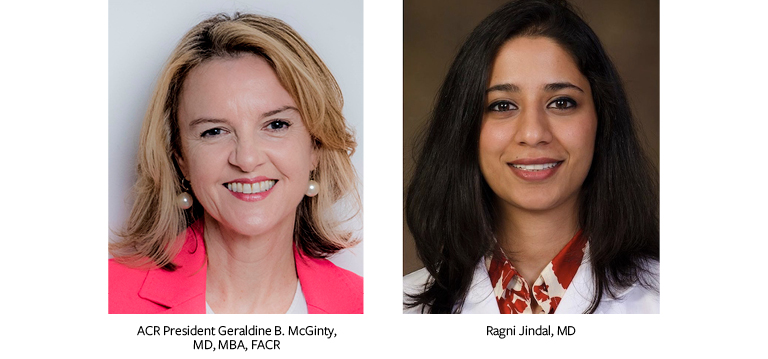ACR President Geraldine B. McGinty, MD, MBA, FACR, believes in empowering her team and giving them supported opportunities to stretch — letting her mentees have the spotlight. This concept of leading from behind is one that she tries to regularly practice in her activities at the ACR and in her role as chief strategy officer of Weill Cornell Medicine.
McGinty spoke with Ragni Jindal, MD, radiology resident at NYU Langone Winthrop Hospital, about the opportunity for radiologists to lead from behind in their own professional relationships.
What does the concept of leading from behind mean to you?
Leading from behind creates an atmosphere with your team that empowers them to take risks. I try to practice it regularly in my work with the ACR. For example, I recently invited Melissa A. Davis, MD, MBA, assistant professor at Emory University, to take over my Twitter feed for a day to share her perspectives on how we can make radiology more inclusive.
In my role at Weill Cornell Medicine, I constantly look for opportunities to allow my team to grow professionally. Just recently, I developed a financial forecasting model for my health system with my team, which I’ve presented to senior leadership on several occasions. For one particular meeting, I wasn’t sure I could change my clinical schedule to present, so I had to entrust this important presentation to a team member. As it turns out, I was able to attend but when I checked in with my colleague, she was ready. She did a terrific job and represented our team effectively. Leading from behind is not always putting yourself out there but using whatever opportunity you can to let your team grow and stretch.
How have other radiology leaders helped you in your role at the ACR?
Early in my career, when I was a member of the ACR’s Commission on Economics, the chair of the Commission, Bibb Allen Jr., MD, FACR, asked me to give a presentation to the ACR Council at a difficult time for reimbursement. The fact that he was willing to let me speak on a pretty challenging topic gave me visibility and credibility within our membership.
There’s never been a time when it has been more important for us to have one voice in radiology. This means that organizations like the ACR need to be a place where radiologists convene and get involved.
What are some of the challenges that radiologists might encounter when leading from behind, and how can they overcome them?
Women are often not given as much credit for their contributions as their male colleagues, so it can feel like a risk to let someone else on your team take the spotlight. I certainly recognize that I’m at a stage in my career where I should be comfortable letting someone else take the stage. However, I’m sympathetic to a mid-career professional, especially a woman or person of color, who is thinking, “I’m already struggling to be heard, so why would I put somebody else out there?” For that person, I’d argue that senior leaders need to act to amplify and sponsor emerging leaders on their team to give those colleagues the confidence that they need to be seen and heard.
What place does this concept play in the future of radiology?
The profession is seeing its fair share of challenges right now — dealing with the ongoing pandemic, understanding financial ramifications, and exploring how we are going to incorporate AI into our workflows. However, there’s never been a time when it has been more important for us to have one voice in radiology. This means that organizations like the ACR need to be a place where radiologists convene and get involved. I am a big proponent of the concept of “new power,” which affirms that successful organizations will be those who open themselves to more engagement and decision-making from their entire membership rather than just a small group at the top (learn more in the JACR® at bit.ly/New_Power). We will maintain our relevance and amplify our voice if we offer opportunities for younger members to be involved — to showcase their talents and to contribute meaningfully.

